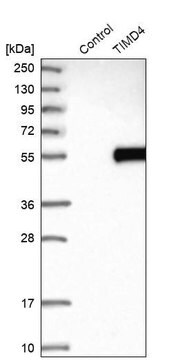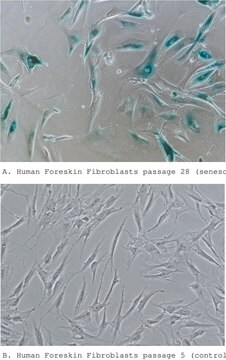MABC958
Anti-TIM4/TIMD-4 Antibody, clone Kat5-18
clone Kat5-18, from hamster(Armenian)
Synonyme(s) :
T-cell immunoglobulin and mucin domain-containing protein 4, TIMD-4, Spleen, mucin-containing, knockout of lymphotoxin protein, SMUCKLER, T-cell immunoglobulin mucin receptor 4, TIM-4, T-cell membrane protein 4, TIM4/TIMD-4
About This Item
Produits recommandés
Source biologique
hamster (Armenian)
Niveau de qualité
Forme d'anticorps
purified immunoglobulin
Type de produit anticorps
primary antibodies
Clone
Kat5-18, monoclonal
Espèces réactives
mouse
Technique(s)
flow cytometry: suitable
neutralization: suitable
Isotype
IgG
Numéro d'accès NCBI
Numéro d'accès UniProt
Conditions d'expédition
dry ice
Modification post-traductionnelle de la cible
unmodified
Informations sur le gène
mouse ... Timd4(276891)
Description générale
Immunogène
Application
Flow Cytometry Analysis: Representative lots were conjugated with biotin and detected Tim4 immunoreactivity among mouse Mac1+ peritoneal cells (Miyanishi, M., et al. (2012). Int. Immunol. 24(9):551-559; Miyanishi, M., et al. (2007). Nature. 450(7168):435-439).
Neutralizing Analysis: A representative lot blocked Tim4-mediated engulfment of apoptotic CAD-/- thymocytes by murine peritoneal macrophages in a dose-dependent manner in culture (Miyanishi, M., et al. (2007). Nature. 450(7168):435-439).
Neutralizing Analysis: A representative lot, when administered via i.v. injection, significantly suppressed the phagocytosis activity of F40/80+ macrophages in the thymus of CAD-/- mice following intraperitoneal dexamethasone injection to induce apoptosis in the thymus (Miyanishi, M., et al. (2007). Nature. 450(7168):435-439).
Apoptosis & Cancer
Apoptosis - Additional
Qualité
Flow Cytometry Analysis: 0.1 µg of this antibody detected TIM4/TIMD-4 in Ba/F3-Tim4 cells overexpressing mouse Tim4.
Description de la cible
Forme physique
Stockage et stabilité
Handling Recommendations: Upon receipt and prior to removing the cap, centrifuge the vial and gently mix the solution. Aliquot into microcentrifuge tubes and store at -20°C. Avoid repeated freeze/thaw cycles, which may damage IgG and affect product performance.
Autres remarques
Clause de non-responsabilité
Vous ne trouvez pas le bon produit ?
Essayez notre Outil de sélection de produits.
Code de la classe de stockage
12 - Non Combustible Liquids
Classe de danger pour l'eau (WGK)
WGK 2
Point d'éclair (°F)
Not applicable
Point d'éclair (°C)
Not applicable
Certificats d'analyse (COA)
Recherchez un Certificats d'analyse (COA) en saisissant le numéro de lot du produit. Les numéros de lot figurent sur l'étiquette du produit après les mots "Lot" ou "Batch".
Déjà en possession de ce produit ?
Retrouvez la documentation relative aux produits que vous avez récemment achetés dans la Bibliothèque de documents.
Notre équipe de scientifiques dispose d'une expérience dans tous les secteurs de la recherche, notamment en sciences de la vie, science des matériaux, synthèse chimique, chromatographie, analyse et dans de nombreux autres domaines..
Contacter notre Service technique








